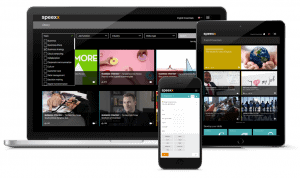Treinamento Corporativo de Idiomas no Mundo Digital
A globalização e a transformação digital estão mudando a maneira como os negócios funcionam. Cada vez mais organizações estão capacitando seus funcionários para manter o ritmo. Simplesmente não basta que as equipes falem apenas um idioma. Quando uma empresa se limita a falar apenas um idioma, perde oportunidades de desenvolver novas parcerias e garantir novos clientes. Muitas empresas estão em estágios diferentes em suas jornadas de transformação digital, possuem dúvidas sobre as melhores práticas quando se trata de treinamento corporativo em idiomas no mundo digital.
Benefícios do multilinguismo para empresas e funcionários
O multilinguismo tem muitos benefícios para empresas e funcionários: melhora a colaboração entre equipes (especialmente quando localizadas em diferentes países). Ajuda a cultivar habilidades sociais como a empatia, necessária para relacionamentos saudáveis com os funcionários. Promove tolerância e respeito e melhora a adaptabilidade a novas culturas de trabalho. Aqui estão algumas dicas de práticas recomendadas para o treinamento de idiomas corporativo móvel bem-sucedido:

Avaliação e Progresso
Primeiro, saiba onde você está e depois determine para onde quer chegar. Avaliar o gap de conhecimento e habilidades de idiomas de seus funcionários é o primeiro passo a tomar antes que você possa tomar decisões informadas sobre onde e como avançar com o treinamento em idiomas corporativo portátil e o treinamento de competências sociais. O “gap de habilidades” também é uma das três principais tendências identificadas pelo relatório Future of Skills do LinkedIn. Você não deve apenas avaliar regularmente os funcionários para encontrar os gaps de habilidades, mas também acompanhar o sucesso das iniciativas de aprendizado da sua organização. O conhecimento o ajudará a fazer escolhas mais inteligentes e estabelecer metas mais atingíveis.
Goals for Mobile Corporate Language Training
Match up objectives and measure learning success effectively. Don’t get caught playing the numbers game. Many HR and learning professionals are still measuring learning success in terms of numbers – the number of hours an employee devotes to learning, the number of employees completing a course – but the problem with these measurements is that they do not reflect greater business objectives. Before investing in training, outline the needs and objectives of both your organization and your workforce and design your training program around that.
Personalization is Key
Do not assume one-size-fits-all training will work for everyone. When it comes to learning a new language for a job, personalization is key to quick and efficient progress – also in mobile corporate language training. The employees in your workforce may hail from different generations and come with ranging levels of work experience, and they will surely have different preferred methods of learning. Learners should have access to bite-sized learning nuggets, a resource library and a skills center with current resources like videos and articles touching on topics relevant to their industry as well as personal interests (to keep them engaged!). Engineers, salespeople, and doctors all have different work scenarios and should be able to learn about relevant topics in their fields, and practice speaking using special terms related to their work.
Thanks to AI, the learning experience is now more personal than ever before – content can be prioritized, curated and delivered at the exact moment of need for individual learners. At Speexx, we use a collaborative filtering recommendation algorithm to send personalized content of interest to our users on a weekly basis. Aside from the need for content to be personalized to fit individuals working in different industries, there’s also the need to recognize the various preferred methods of learning and learning delivery. Keep in mind that people prefer their morning coffee differently, just like they have different learning preferences.
Go Mobile for Corporate Language Training
There’s no doubt that mobile learning provides much-needed flexibility for modern learners. In the age of digital transformation one simply can’t afford to exclude mobile learning opportunities. According to a recent survey conducted with over 700 HR professionals, 21% say BYOD (Bring Your Own Device) is not allowed in their organizations. They are blocking the delivery of effective mobile training. In order to achieve learning in the flow of life, learning on-the-go via a mobile language app will be necessary to help learners achieve maximum flexibility between work, personal life and learning. Employees can make best use of their time while waiting during a layover or a daily commute, and practice their vocabulary on-the-go. It’s the perfect answer to providing on-demand and point-of-need learning.
Provide a variety of learning methods – not only one.
Some employees may prefer speaking with their language trainer through 1:1 phone calls. Others may be more keen on learning with peers or other industry professionals from around the world via virtual classrooms or webinars. Younger generations may prefer a more gamified approach. They will favor learning on-the-go via a mobile language app. Macro and microlearning are also proven methods for providing modern learners with interesting and engaging mobile corporate language training experiences. Be sure your content is not only personalized to fit the needs of your employees located across different locations, teams and industries. Make it suitable for different types of learners.
Modern learners have less time to dedicate to learning. Adapting the way training is delivered will be key to successfully delivering corporate language training through digital or blended learning initiatives.
